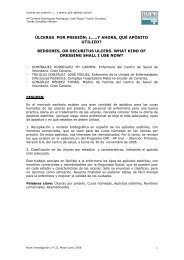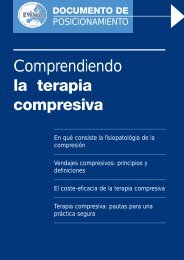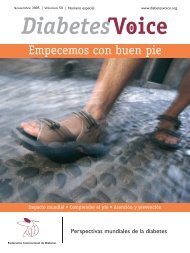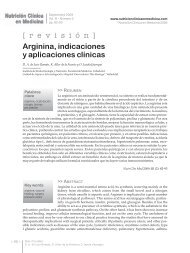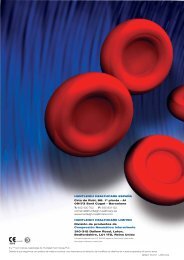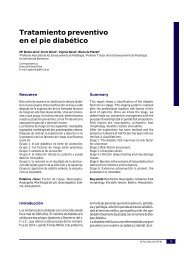Descargar - Úlceras.net
Descargar - Úlceras.net
Descargar - Úlceras.net
- No tags were found...
Create successful ePaper yourself
Turn your PDF publications into a flip-book with our unique Google optimized e-Paper software.
20 ■ PIE DIABÉTICO1. Extensive calcification of the arterial wall.2. Predominant involvement of tibio-peronealvessels (posterior tibial, anterior tibial andperoneal arteries).3. Less involvement of of aorto-iliac sectorbut with typical involvement of the externaland common femoral arteries.4. Sparing of foot arteries: frequently the pedalartery, the plantar arch and its branchesare patent often with segmental stenosis5. Frequent involvement of the hipogastric andprofunda femoris arteries that can presentwith diffuse disease, compromising importantcollateral pathways. The latter can be affecteduntil its distal segment, compromising outflowtargets in proximal revascularization.MicroangiopathyThe classical concept of occlusive microangiopathyas the hallmark of Diabetes relatedPAD, first described by Goldenberg(12),was not clearly demonstrated in recent studies(3).In histological and hemodynamic studiesno significant occlusions at the arteriolarlevel were noted. However other pathologicalchanges of the microcirculation were identifiedthat can explain the increased incidenceof trophic lesions and the aggressive course ofPAD in diabetic patients:1. Thickening of the basal lamina: this alterationinduces changes to blood vesselpermeability, reduces nutrient supply andmetabolite clearance to the arterial walland facilitates leucocyte migration and arterialwall inflammation. Apparently oxygendelivery is not affected.2. Endothelial cell disfunction: Severalmechanisms like hyperglycemia, free fattyacid production and insulin resistance contributeto endothelial cell dysfunction. Anend result of these mechanisms is a significantlyreduce bioavailability of nitric oxide,which in turn induce derangements in theregulation of blood flow and increase the localinflammatory state of the vascular wall.NeuropathyDiabetic polyneuropathy is one of commonestcomplications of DM. Its character-ized by distal motor-sensory and autonomicinvolvement of the lower and upper limbs(“stocking and glove distribution”). It’s causedby progressive demielinization of the peripheralnerves induced by hyperglycemia.The simultaneous presence of sensoryloss, motor deficits and autonomic deregulationcontribute to the development of mechanicaland postural changes of the foot(9).These changes, when combined with hyposthesiacan explain the appearance of hyperpressurelesions in foot locations associatedwith weight-bearing.Infection and immunologicalimpairmentInfections in diabetic patients can be rapidlyprogressive, inducing extensive destructionof soft tissues. Frequently small wounds in adiabetic foot lead to infection with extensivecellulitis, gangrene and fulminant sepsis thatrequire emergent treatment (13). Minor infectionscan rapidly degenerate in gangrene oftoe and involvement of the forefoot withproximal progression mainly in the tendinoussheaths and causing extensive soft tissue infection,osteomyelitis, abscess formation, skinnecrosis and ascending lymphangytis (fig. 1).Anaerobic infections are very commonand may be responsible for extensive necrotizitingfasciitis extending proximally.Figure 1. Diabetic foot infection with necrosis ofthe hallux and extensive soft tissue infection anddestruction.









